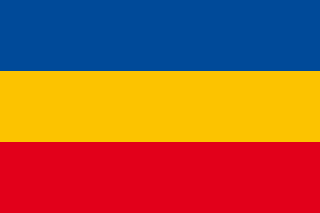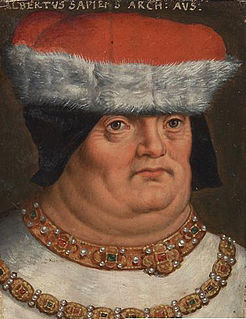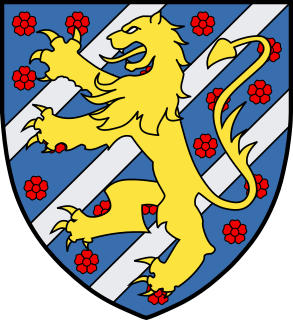
The Duchy of Mecklenburg-Schwerin was a duchy in northern Germany created in 1701, when Frederick William and Adolphus Frederick II divided the Duchy of Mecklenburg between Schwerin and Strelitz. Ruled by the successors of the Nikloting House of Mecklenburg, Mecklenburg-Schwerin remained a state of the Holy Roman Empire along the Baltic Sea littoral between Holstein-Glückstadt and Duchy of Pomerania.

Albert II, known as the Wise or the Lame, a member of the House of Habsburg, was Duke of Austria and Styria from 1330, as well as Duke of Carinthia from 1335 until his death.

Euphemia of Sweden was a Swedish princess, spouse of Albert II, Duke of Mecklenburg, Duchess consort of Mecklenburg, heiress of Sweden and of Norway, and mother of King Albert of Sweden.

The House of Mecklenburg, also known as Nikloting, is a North German dynasty that ruled until 1918 in the Mecklenburg region, being among the longest-ruling families of Europe.
The Albertinian line was a line of the Habsburg dynasty, begun by Duke Albert III of Austria, who, after death of his elder brother Rudolf IV, divided the Habsburg hereditary lands with his brother Leopold III by the 1379 Treaty of Neuberg. The branch finally became extinct in the male line with the early death of Ladislaus the Posthumous in 1457.
This page describes relatives of Jogaila, who was Grand Duke of Lithuania, and, known under the name Wladyslaw II Jagiello, king of Poland. Family relations up to two generations before him, and three generations after him are mentioned.
House of Algirdas refers to the siblings, children, and grandchildren of Algirdas, Grand Duke of Lithuania from 1345 to 1377. The family was from the Gediminids dynasty. Algirdas' son Jogaila started the Jagiellon branch of the dynasty.
Ingeborg of Denmark was the eldest daughter of Valdemar IV of Denmark and his wife Helvig of Schleswig. By marriage she was Duchess of Mecklenburg, although she died before her husband succeeded her father-in-law. She was potential heiress to the Danish throne and was the older sister of Margaret I of Denmark.

Henry IV, Duke of Mecklenburg was from 1422 to 1477 Duke of Mecklenburg.
William of Werle, was co-regent of Werle from 1418 to 1425, then the sole ruler from 1425 until his death. After 1426, he called himself "Prince of the Wends". He was a son of Lorenz of Werle-Güstrow and his wife Matilda of Werle-Goldberg.

Eric I, Duke of Mecklenburg was a Duke of Mecklenburg and heir to the throne of Sweden.
Henry III, Duke of Mecklenburg was Duke of Mecklenburg from 1379 until his death.

Bogislaw VI, Duke of Pomerania was duke of Pomerania-Wolgast.
Henry II, Lord of Mecklenburg, nicknamed the Lion was regent of Mecklenburg from 1287 to 1298, co-regent from 1298 to 1302 and ruled alone again from 1302 to 1329.














